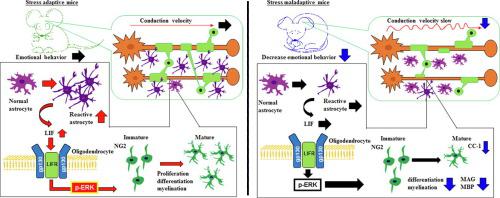Neuroscience ( IF 2.9 ) Pub Date : 2020-08-29 , DOI: 10.1016/j.neuroscience.2020.08.030 Kazuhiro Kurokawa 1 , Minoru Tsuji 1 , Kohei Takahashi 1 , Kazuya Miyagawa 1 , Atsumi Mochida-Saito 1 , Hiroshi Takeda 1

|
Leukemia inhibitory factor (LIF) has been shown to be involved in myelination. The present study investigated whether LIF plays a significant role in the formation of stress adaptation using stress-adaptive and -maladaptive mice, and also attempted to confirm whether there was any difference in myelination between these animal models. A single exposure to restraint stress for 1 h induced a decrease in head-dipping behavior in the hole-board test. This stress response was not seen in mice that had been exposed to restraint stress for 1 h/day for 14 days, which is referred to as stress adaptation. In contrast, repeated exposure to restraint stress for 4 h/day for 14 days did not lead to the development of stress adaptation, and was still associated with a decrease in head-dipping behaviors. Under these conditions, LIF protein was found to be increased with astrocyte activation in the hippocampus of stress-adaptive mice, whereas no change was observed in stress-maladaptive mice. On the other hand, major myelin proteins including myelin-associated glycoprotein and myelin basic protein, as well as mature oligodendrocytes, were decreased in the hippocampus of stress-maladaptive, but not stress-adaptive, mice. Furthermore, while the levels of phosphorylated-extracellular signal-regulated kinase (p-ERK) were increased in the hippocampus of stress-adaptive, this change did not occur in stress-maladaptive mice. Taken together, the present findings suggest that LIF, which may be derived from activated astrocytes, plays a critical role in the maintenance of hippocampal myelination via an ERK signaling pathway, and contributes to the development of stress adaptation.
中文翻译:

白血病抑制因子通过小鼠海马髓鞘化参与应激适应的形成。
白血病抑制因子(LIF)已被证明参与髓鞘形成。本研究调查了LIF在使用应激适应和适应不良小鼠的应激适应形成过程中是否发挥重要作用,并试图确认这些动物模型之间的髓鞘形成是否存在任何差异。在孔板测试中,单次暴露于约束应力1 h导致头部浸入行为的降低。在暴露于约束压力下持续1 h / day达14天的小鼠中未观察到这种压力反应,这被称为压力适应。相比之下,每天连续4天/小时连续4天暴露于约束压力下并不会导致压力适应的发展,并且仍然与头浸行为的减少有关。在这种情况下 发现在应激适应小鼠的海马中,LIF蛋白随星形胶质细胞激活而增加,而在应激适应小鼠中未观察到变化。另一方面,在应激适应性但不是应激适应性小鼠的海马中,主要的髓磷脂蛋白,包括髓鞘相关糖蛋白和髓鞘碱性蛋白,以及成熟的少突胶质细胞,都减少了。此外,虽然在应激适应性海马中磷酸化细胞外信号调节激酶(p-ERK)的水平增加,但这种变化在应激适应性小鼠中并未发生。综上所述,目前的发现表明,LIF可能源自活化的星形胶质细胞,在通过ERK信号通路维持海马髓鞘形成中起关键作用,并有助于应激适应的发展。











































 京公网安备 11010802027423号
京公网安备 11010802027423号